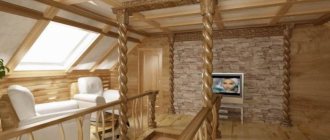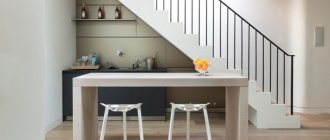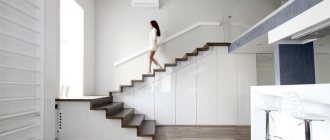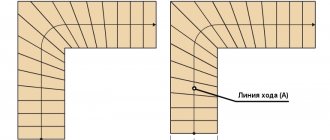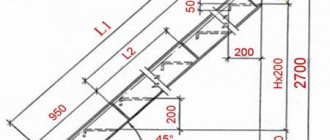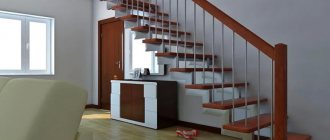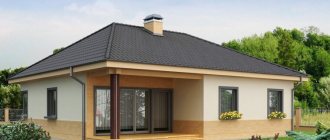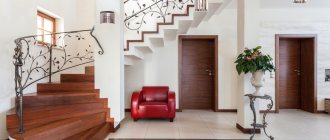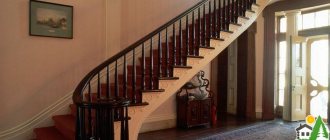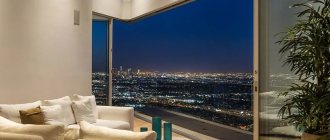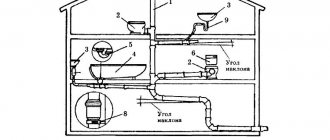The presence of two or more floors in a private house in itself indicates that it cannot do without stairs. Well, the stairs themselves in such conditions most often perform not only a functional role, but also are a decorative element of interior design.
Staircase lighting – which system is better to choose?
When designing and constructing such interfloor passages, many different nuances are taken into account. And the first thing that needs to be taken into account when starting such work is to ensure the maximum degree of operational safety of the structure being created. This concept can include such points as non-slip steps that are comfortable for climbing in height and width, an optimal slope angle for flights of stairs, comfortable and durable fences. And another safety parameter is effective staircase lighting. It is clear that the lighting of staircases inside a private house should also play a decorative role, that is, fit organically into the overall style of decoration of the premises.
Find out how to decorate the space under the stairs with your own hands from our new article on our portal.
Next, we will talk specifically about providing illumination for these interfloor transitions, which can be arranged in different ways, and using various lighting devices.
How to organize staircase lighting
Before thinking about lighting the staircase to the second floor in a private house, do not forget that first of all it should be comfortable. It doesn’t matter what you choose - chandeliers, sconces or ribbon. The main thing is that each step is well lit. Otherwise, the stairs pose a great danger, especially in a house where there are children.
To avoid overpaying for electricity, install motion sensors. It is very comfortable. As soon as someone approaches the steps, the light comes on, and when no one is there, the lights go out on their own. If there is such a sensor, then you do not need to look for the switch every time.
Staircase lighting may vary. The easiest option is to attach lighting sources to the ceiling and walls. And to make the interior more comfortable, you can also illuminate the steps. In the photos of interiors of different styles you can see that steps look more interesting if several sources are used to illuminate them. It can be:
- ceiling chandelier;
- sconce;
- Spotlights;
- LED Strip Light;
- designer lighting.
Don't be afraid to experiment and make mistakes. It is better if the steps to the second floor are illuminated with lamps and lamps located at different heights. And if after the renovation you feel that there is too little light on the flight of stairs, place a compact floor lamp in the corner. Even a forged street lamp can fit into an Italian interior.
Choosing a location for installing foot lighting
- Wall sconces are distinguished by their beauty and grace, however, in order to illuminate the entire span, it is necessary to hang several sconces at a small distance from each other, which does not always look quite aesthetically pleasing.
- Recessed lighting for stairs remains the most popular option. Installation is carried out secretly, all wires are hidden in the steps, behind the wall panel or inside the staircase elements.
- Floor lamps (miniature spotlights) are installed on the floor and directed to the segment of the span that needs lighting.
Ceiling chandelier
Do you have high ceilings at home? The right interior solution would be to choose a chandelier for the staircase in the house. If there are many steps, a cascading lamp will do. Note that today this is not the most popular lighting option. But if it seems most suitable to you, choose a chandelier that will match the style of the rest of the interior. For example, if you have a classic design and a wrought iron staircase, then the lamps can also be wrought iron. For a loft-style room, a wooden lamp with metal elements is suitable.
If the chandelier will be the only lighting fixture, choose a large one with bright lamps. It is desirable that it illuminates every corner. There should be switches at the bottom and at the top - their location is thought out at the early stages of repair.
Dimmer, RGB controller and amplifier for staircase lighting with ice tape
Additional equipment will be needed in three cases:
- Brightness adjustment is required - install a dimmer;
- multi-color ice tape is used - an RGB controller is installed;
- The dimmer/controller power is not enough - an amplifier is added.
All these devices are connected to an electrical circuit between the power supply and the tape. Connection options are shown in the figures:
Wall sconces
Wall sconces are suitable for lighting the steps to the second floor in a private house. They are made in different styles: classic, Scandinavian, modern, minimalism, Provence. This lighting option is suitable for long staircases to the second floor, because the sconce illuminates a large area. One such lamp will be enough for a small house in the country, and 3-5 for a huge one. They are placed at a distance of 1-1.5 m and closed in one circuit.
The location of the lamps is thought out at the early stages of repair, and wiring is done for them. But if you decide to place the sconces after you have painted the walls, then use decorative cable ducts to hide the unsightly wires.
Beauty, safety, savings
Automatic lighting gives a very impressive appearance. In addition, the safety of movement increases. In addition to this there are other benefits:
- There is no need to feel for a switch on the wall in pitch darkness.
- Even if only slightly, energy is saved. Due to automation, the system is in an economical standby mode.
- Using automation tools when installing lighting, you can set up beautiful visual effects.
And you don’t have to worry that it’s expensive and inaccessible to an inexperienced user. The entire set of additional lighting is initially very inexpensive, and can easily bring additional comfort and benefit to residents.
Spot directional lighting
You can highlight the stairs to the second floor using spotlights. They are small, give less light, so for the same room you need more of them than sconces.
Such lighting fixtures can be mounted in the ceiling, walls, doorways and steps. Make some switches. So, one of them will light the ceiling lamps, and the other will light the stairs. If decorative niches are made along the steps, spotlights are also installed in them. The recess can be built to look like a window (this will make the home interior even more comfortable).
The idea of spot wall lighting remains popular. If you want to implement it in your interior, it is recommended to decorate the walls with plasterboard. You can easily cut the required number of holes of any diameter in it. This is much more difficult to do in a brick or concrete wall.
Preparing for installation
If there is no ready-made kit for lighting the steps of the stairs, you need to think through the lighting scheme yourself. It's not difficult at all. In this age of the Internet, you can find almost everything on this topic.
If you have already decided where all the necessary elements will be placed, it is best to sketch out a small drawing on a blank sheet of paper with connection elements with their installation locations directly on the stairs. This will give you a clearer picture of the future outcome of your project.
Knowing the initial dimensions of the room, the dimensions of the stairs and flights of stairs, it is not difficult to calculate both the footage of the LED strip and the number of sensors that will work in the future lighting system.
This type of lighting scheme is often found on the Internet:
This scheme is quite workable if you use a regular and inexpensive strip of LEDs. Although there is a significant drawback to it. It is necessary to install a special controller for each piece of tape. That's how many steps there are, that's how many sections of LED strips there are. Each strip needs its own output and all the wires are combined together. Therefore, already at the output of the controller you get an impressive braid of wires.
But the most interesting effects are provided by the addressable RGB LED strip. In addition to simplifying the scheme, we will get the color design of the steps with a variety of color effects.
If anyone doesn't know, we'll explain. The addressable LED strip makes it possible to control a separately soldered LED. And each LED in the strip is capable of producing about 16 million different shades!
A more simplified diagram of the project “staircase lighting on steps with a motion sensor” can be presented in this version:
Now about the details.
Addressable type light strips are highly directional and are connected to the DI pin.
As can be seen from the example, all separately cut strips of tape are connected through D0 to DI.
We recommend using ws2811 chip strips to illuminate small flights of stairs.
Tapes of this type can be powered from a 12 V source. Every three LEDs in this strip are controlled by their own chip, which produces a certain light on the 3 LEDs for which it is responsible.
We advise you to buy a roll of tape (or as much as you need according to your calculations) on the Chinese trading platform Aliexpress. You will not lose in quality, but you will definitely gain in price. For some reason, in our retail chains similar tapes cost orders of magnitude more than in China.
At the time of writing, a five-meter roll of tape with a density of sixty diodes could be purchased for only 700 rubles.
A denser arrangement of LEDs is also on sale, and costs more. But for staircase design there is no point in buying such a strip, since 60 LEDs per meter is the optimal parameter for illuminating steps.
Now we need to talk about one more parameter.
There are tapes on sale with different degrees of moisture protection - IP:
- IP30 without protection;
- IP65 - silicone coated tape;
- IP67 - sealed tape in a silicone casing.
It doesn’t make much sense to buy IP67 for indoor stairs, but illumination of stair steps from IP30 or IP65 is at the discretion of the owner. It seems to us that giving preference to IP65 would be wiser. Do you still need to wash the steps sometimes?
Here on Ali Express you can find the bright tape. It will cost an order of magnitude more, but you will benefit from the power of the luminous flux - the light will be much brighter.
Immediately on Ali you need to select a microcontroller to control the tape. We recommend paying attention to similar devices on the Arduino Nano platform.
LED Strip Light
This lighting option is now actively used in a wide variety of interiors. It is well suited for small rooms, narrow stairs, rooms with low ceilings. An LED strip does not require as much space as a sconce, chandelier or floor lamp, but it provides no less light.
The tape is sold by the meter, so before going to the store, decide where and how it will be placed. It is very easy to install - many types have an adhesive backing.
To achieve uniform illumination of the corridor, the tape can be placed in several places. It is usually glued under steps and handrails. If there is no sconce on the walls, a structure is attached to it, which is also glued. If there are niches or paintings, they can also be additionally illuminated. The tape is very flexible, so it is actively used in the design of various interiors. The drawings on the walls lined with LED tubes look unusual. Install a motion sensor, then the light will turn on automatically.
Calculation of tape length and power supply power
Let's assume that you decide to highlight the steps of the stairs. Their total number is 10 pieces, width – 1 meter. Thus, you will need 10 meters of tape or two five-meter rolls. The ice tape is cut into meter-long fragments, which are connected in series into a train with a total length of no more than 5 meters.
Exceeding the length of the cable over 5 meters is not allowed. The reasons are a large voltage drop, a decrease in brightness, and burnout of current-carrying tracks on the printed circuit board.
It turns out two loops of five meters each. You can connect them to separate low-power power supplies, or in parallel to one, more powerful AC/DC converter.
Then you need to calculate the total load power and add a margin of 25% to it. Let's say it turns out to be 100 W, add another 25 W, we get 125 W. It is based on this indicator that it is necessary to select the rated power of the power supply.
Designer lighting
Designers consider using only one type of lighting too boring, so they often create unusual combinations. Thus, classic interiors are simultaneously illuminated by sconces and chandeliers. You can find forged models and the same lamps with beautiful lampshades.
Spot lighting for stairs is rarely used independently. In such an interior there may be sconces in a modern style or ceiling lamps. You can combine LED strip, sconces and floor lamps in one room. There are no restrictions or requirements if everything fits into the overall design concept. The main thing is that the light sources are in the same style, combined with the decoration, stairs and decorative items.
Beautiful design ideas
The multi-colored LED lighting of the staircase will give a new look to the surrounding space. This design technique will create a unique and inimitable atmosphere in the interior of the house.
The photo shows the design of a staircase with multi-colored lighting in the interior of the house.
An unusual solution is to decorate the steps of the stairs with garland, lanterns or candles, which can be lit only when necessary.
Methods of lighting stairs
The staircase to the second floor becomes an important element of the interior of the entire house (even the semantic center). Therefore, its lighting should be thought out as much as possible. With the help of light, you can highlight zones and emphasize them.
During preparatory repair work, immediately determine how the lighting will turn on: automatically or manually. If you choose the first option, you will need to install motion sensors. If the second one suits you, then you will need to install switches in several places.
Where can I buy
You can purchase equipment for creating lighting either in a specialized store or online in an online store. In the second case, the budget option for purchasing products on the Aliexpress website deserves special attention. For some video cameras there is an option for shipment from a warehouse in the Russian Federation; they can be received as quickly as possible; to do this, when ordering, select “Delivery from the Russian Federation”:
| Compatible Arduino Nano controller with bootloader | Wireless LED strip with motion sensor | IR sensor HC-SR501 |
| Light Sensor Module LM393 | Power supply 5,12,24,36,48 Volts | Digital electric soldering iron |
Automatic backlight
Its installation will save you from having to manually turn on the light. To turn the backlight on automatically, you can set:
- Motion Sensor;
- timer;
- sound device;
- load sensor
The first one will be triggered when someone approaches the stairs. The timer can be set for the period of time during which you are at home. But this is not always convenient. If you install a sound sensor, the light will light up when you clap your hands or when talking. The load sensor is triggered when you place your feet on a step or touch the railing.
When choosing a backlight, remember that any automation can malfunction and one day not work. In this case, you should know how to turn off all sensors and where the regular switch is located in the house.
Necessary materials
To make automatic lighting for the stairs yourself, you need lighting for each step of the stairs, calculating the distance from the edge to five centimeters.
Traffic metering devices can be installed at the top and bottom positions. The lighting control function will be performed by a specific device.
A device for adjusting the lighting should be installed. The general parameters of the tape must be as follows: there must be at least 60 diodes per meter of product, their dimensions are 3.5 * 2.8 mm, the Ingress Protection Rating must be at least 67.You can use other options and materials for lighting stairs. We looked at the most popular option.
How to make a transformer with your own hands - step-by-step instructions, diagram, drawings, list of materials + photo of a finished homemade transformerWhich hidden wiring detector is better? TOP 10 best manufacturers with photos and descriptions
Technological maps in construction - what is it?
Arrangement of wireless and conventional network lighting
Today, wireless lighting is used to illuminate stairs. It is safe and very comfortable. This system consists of an autonomous power supply, lighting fixtures and motion sensors.
This design can work even if there is a power outage in the house. It turns on in the dark. To install the devices, you do not need to drill the walls and ceiling. Even a person without special training can handle their installation. The system is safe: it cannot overheat, and the possibility of a short circuit is eliminated.
Compared to wireless, network has its disadvantages. To do this, you need to plan the location of the switches in advance and route the wires under them. It is expensive and the work can only be done by specialists. If there is a power outage, the network backlight will not work. There is also a risk of short circuits and overheating. If a wire in the wall is accidentally drilled or a nail is driven into it, the entire wiring will fail, and in order to repair it, everything will have to be redone again. Experts recommend that owners of new houses install wireless wiring - it’s easier and safer.
Recommendations for organizing lighting
When choosing the type of backlight, several features are taken into account:
- First of all, you should pay attention to the length of the descent. The longer the flight of stairs, the more light is required.
- The devices should emit a calm light that will not dazzle a person or irritate the eyes.
- Energy consumption should be economical since the backlight requires frequent use.
- You need to take care of safety and install an autonomous type of lighting that will operate using a battery or accumulator in the event of a power outage.
- The light flux should not create shadows or distort the configuration of the steps.
Types of lamps for lighting stairs
To illuminate the stairs to the second floor in a private house, you can use:
- LED bulbs;
- LED tubes;
- Spotlights;
- sconce;
- chandeliers.
Lighting fixtures can contain lamps that emit cold or warm light. Which one to choose depends on personal preferences and interior style. So, the tape consists of a thin metal sheet on which LEDs are attached. Or they are located inside the tube. Tapes and tubes come in different colors, so they are suitable for any room. They emit warm, diffused light and make any interior more comfortable and truly homely. Such tubes can be placed along the stairs, and the border of each step can be marked with tape.
There are different types of sconces. In classic interiors they use the simplest ones, which are attached to the wall. Less popular are built-in ones. To install them, you need to drill a hole in the partition. Sconces with a bracket are suitable for loft, minimalism and other modern styles. With its help, you can adjust how far the lampshade will be from the wall.
Spot devices scatter light evenly and last a long time. But they heat up quickly, so when installing, you need to make sure that they do not come into contact with carpeting or wooden objects.
Selecting the type of light bulbs
Incandescent lamps are practically not used for illumination and illumination due to low efficiency and high heating temperature.
Therefore, it is more advisable to install on stairs:
- LED lamps are the most favorable in terms of the ratio of light emitted per watt consumed; connecting LED lamps is suitable in almost any case, which makes them a universal option;
- fluorescent - inferior in efficiency and service life to LEDs, they also contain toxic mercury;
- halogen - one of the cheapest, but provides poor lighting performance and has a short service life;
- neon - do not give a lot of light, but have a wide range of colors, for which they are often used in backlights.
Illuminated staircase design
Lamps should fit into the overall design of the staircase and become its decoration. Their choice depends on the style of the interior. If you like classics, then wrought-iron sconces will suit you, each of which has two lampshades, plain or with a floral print. Such devices are placed between paintings in gold frames. If there is a lot of wood in the interior, look for lamps with wooden lampshades.
Square spotlights will fit into a Scandinavian interior. They can be built into steps or installed along the stairs. They are also suitable for loft and minimalism style. For the latter, select square light sources in steel frames. If several light sources are used, they should all be in the same style and complement each other.
In order for the stairs in a private house to be not only functional, but also stylish, you need to choose the right lighting for it. The interior will become cozy if you combine sconces, chandeliers, floor lamps, spotlights and other light sources in one interior.
System installation
Installing the tape under the step is best done with double-sided tape. The surface is treated before sticking. Dust particles are removed and the surface is cleaned with a solvent.
The wiring for the lamps is laid in the cable channel.
- Wall option.
- Under the stairs.
Since the tape is attached under the step, it is more advisable to cover it with a small visor.
After installation work, it is necessary to carry out a test run of the system. If malfunctions are found, they must be eliminated or amendments must be made to the operation of the software module.
Description
All elements of the lighting system operate autonomously. Each device contains 3 batteries.
More extensive information on the operation of autonomous backlight can be obtained either from the product data sheet, or you can find the desired model on the Internet.
But in any case, such a system will not require much effort for installation, and the stairs will no longer be a source of increased danger.
Standard kit
- lamps - 5 pieces;
- motion sensors - 2 pieces;
- installation instructions.
What is attractive about staircase lighting:
- When a person enters the field of view of the sensor installed before the start/descent of the stairs, a smart autonomous motion sensor installed on the stairs is triggered, which transmits a control signal to all lighting elements.
- The wireless circuit allows you to install elements in any, even the most inaccessible places.
- The maximum distance between all elements of the system is about 16 meters.
DIY step lighting
The installation of stage lighting using recessed luminaires must begin with planning. At this stage, it is necessary to calculate the places where the lamps will be installed, their number, connection diagram and activation method. That is, what will be used as a switch - a button, a motion sensor or some other element.
After purchasing all the lighting elements for the steps, you can begin their installation:
- Marking. As a rule, lamps are installed approximately in the middle of the vertical part of each step. From 2 to 6 lamps can be installed on one stage. If there are more of them, you need to select the power so that the light does not blind your eyes.
- Holes for lamps are cut using a round cutter installed in an electric drill or hammer drill.
- When all the holes are ready, lamps are installed in them.
- Next, all the lamps are connected to each other in a parallel circuit. All wires must either be soldered, or special connectors must be used for better contact. The wires are placed in a thin box, attached to the inside of the stairs with double-sided tape.
- The main wire is connected to the motion sensor control unit or to a regular switch mounted on the wall.
If the staircase is not a light wooden structure, but a concrete monolith, you need to reconsider the way you install the lamps.
There is no need to install them in each step: this is a very labor-intensive process in this case.
As an alternative, you can place lamps opposite each step so that the beam falls on its surface. In this case, the wires can be easily hidden in a shallow groove on the same wall.
Advertising design
Very often, step lighting is used as advertising. In this case, the logo or name of the advertised product or service is displayed with LED strip. After all, it is flexible and can change colors according to the customer’s wishes.
You can place running line lighting on the steps. In this case, there is a double benefit - advertising and lighting.
Important! You can implement advertising lighting in an expensive but original way - install a laser gun, which will highlight the necessary pictures and words on the steps.
